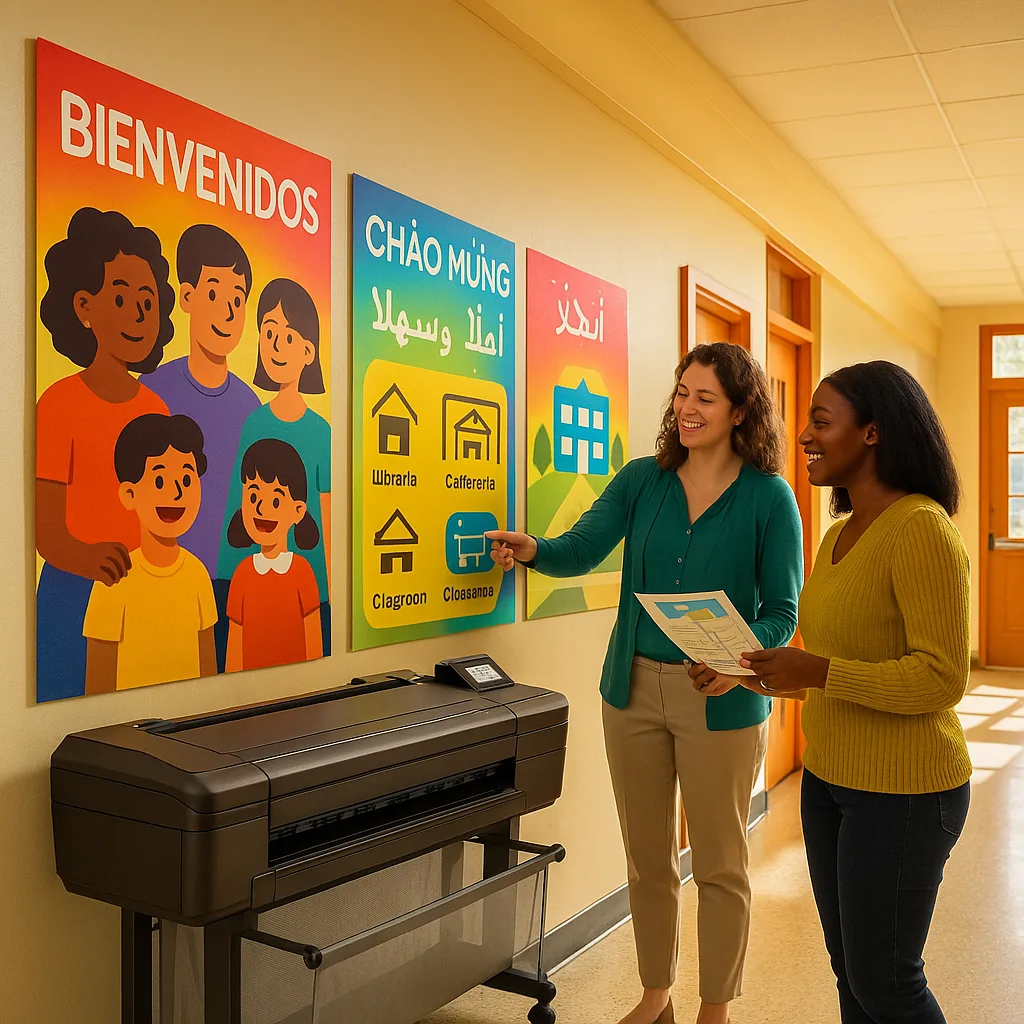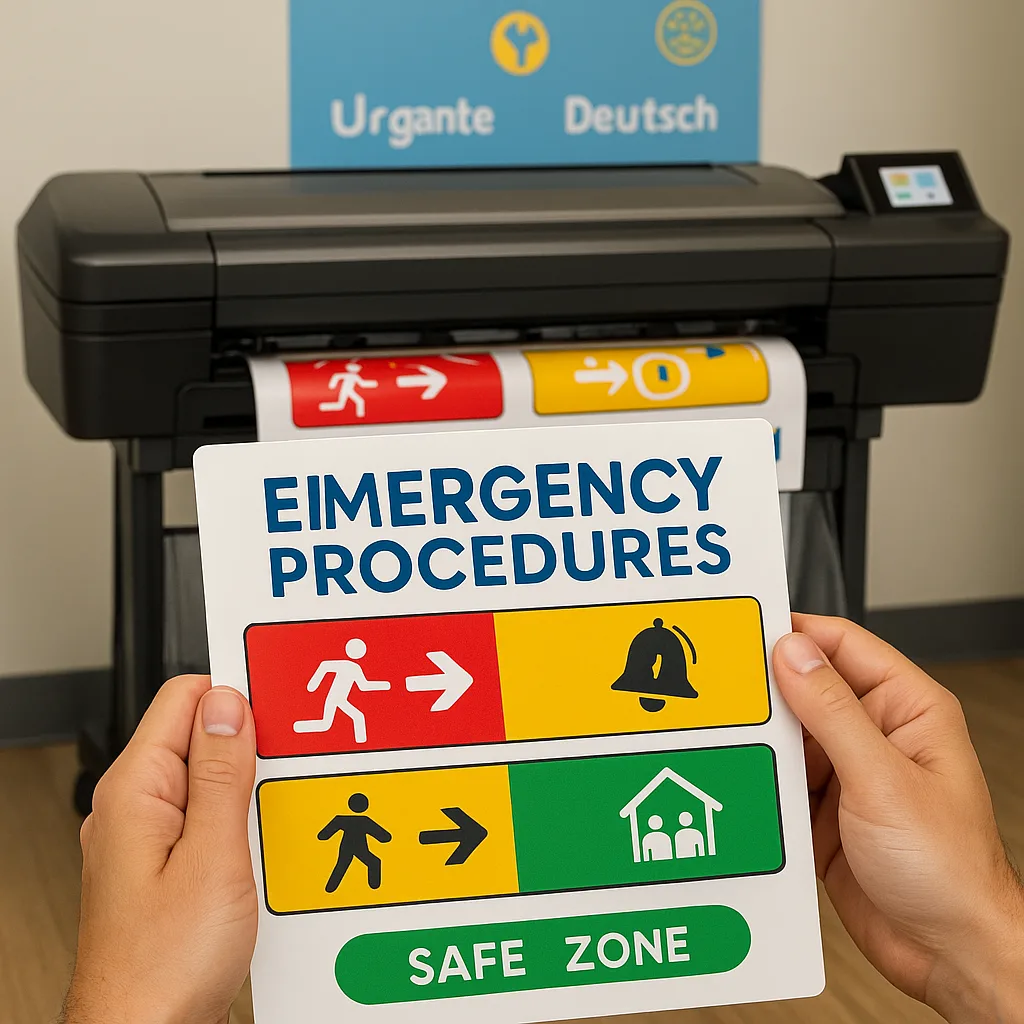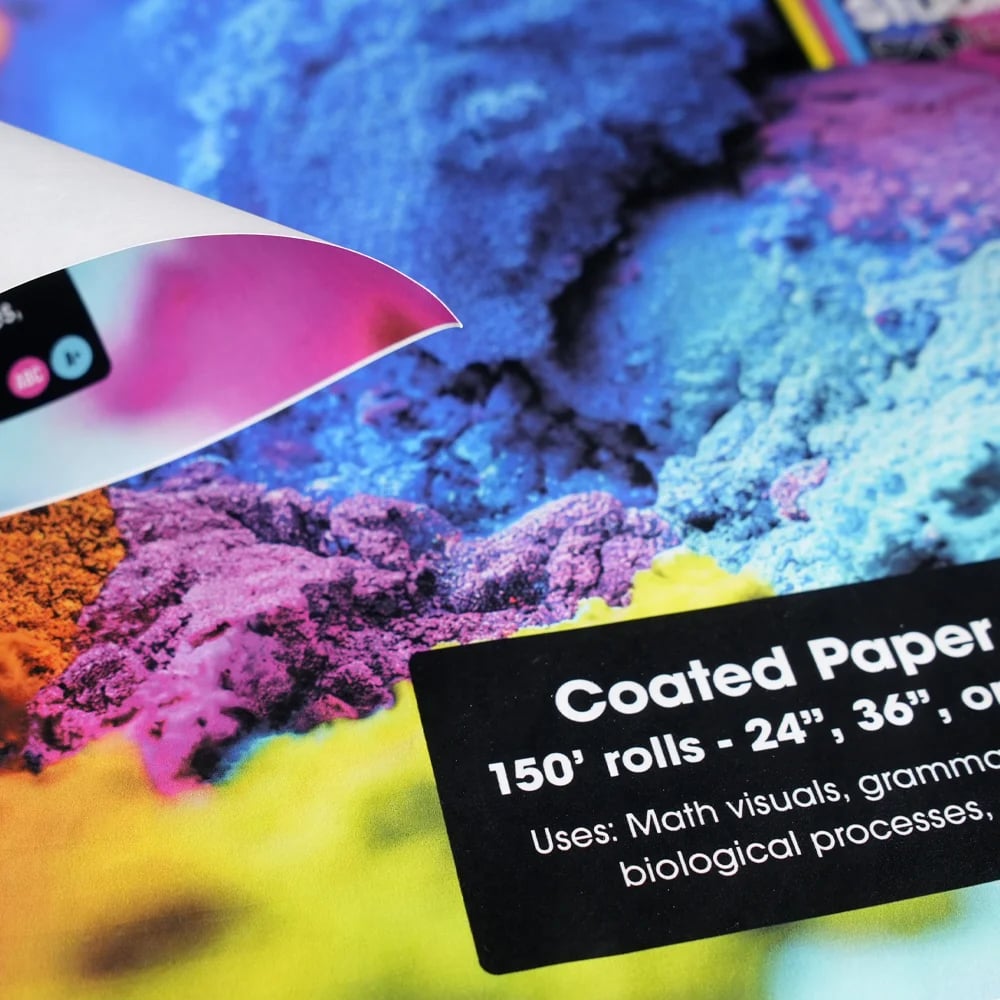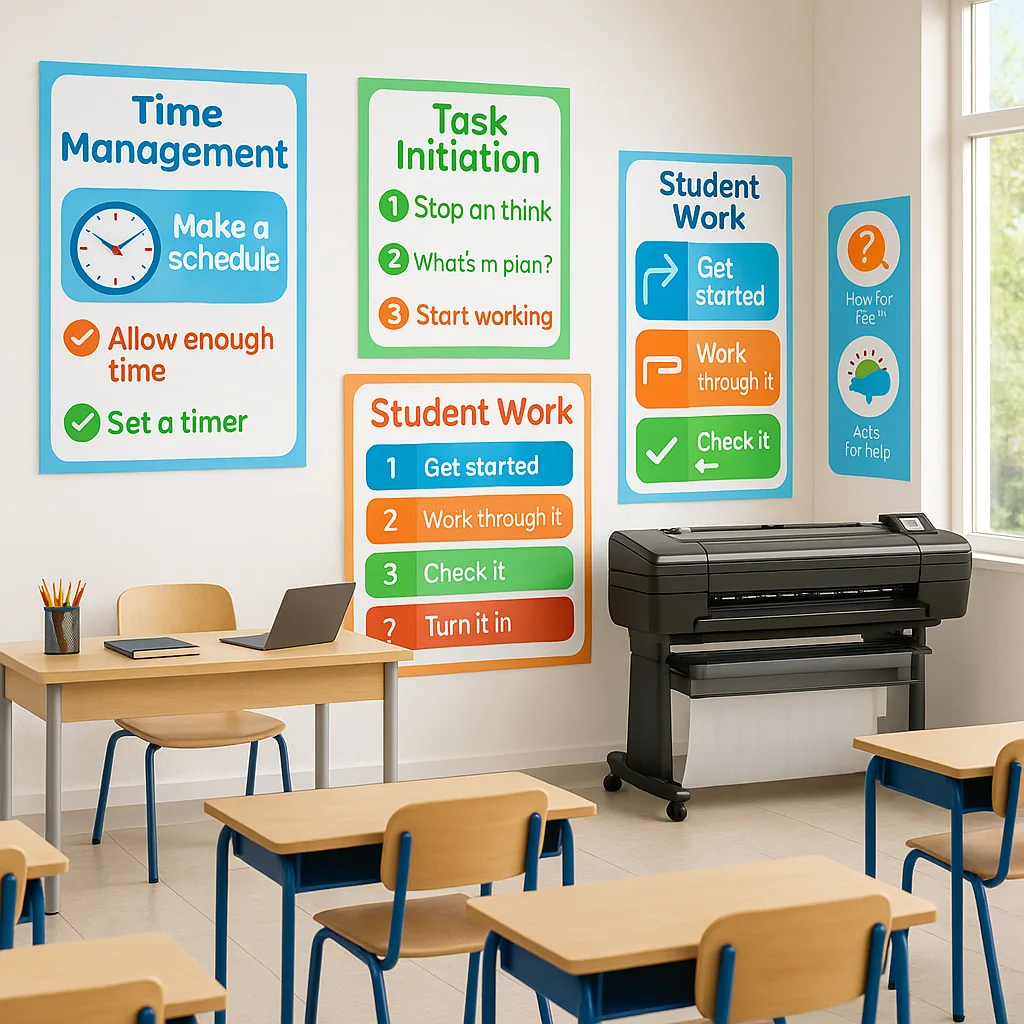
School Poster Printer for Multilingual Communication
Breaking the Language Barrier: Real-Time Visual Translation Strategies for Parent-Teacher Communication
In California’s increasingly diverse educational landscape, effective parent-teacher communication has become a critical factor in student success. With over 40% of California students speaking a language other than English at home, schools must move beyond traditional communication methods to truly engage all families in their children’s education using innovative visual strategies with a school poster printer multilingual communication approach.
The State of Multilingual Communication in California Schools
According to the California Department of Education, approximately 1.1 million students are classified as English Learners, representing 18.6% of total public school enrollment. These students speak over 75 different languages, with Spanish comprising 80.6% of EL students, followed by Vietnamese (2.2%), Mandarin (1.8%), and Arabic (1.5%). This linguistic diversity presents both challenges and opportunities for meaningful parent engagement.
Traditional translation approaches often fall short because they focus solely on literal word-for-word conversion without considering cultural context, visual literacy levels, or the emotional resonance needed to build trust between home and school. Furthermore, many families face additional barriers beyond language, including varying educational backgrounds, work schedules, and cultural expectations about school involvement.
The shift toward visual communication strategies using a poster printer machine for schools represents a paradigm change in how educators approach multilingual outreach. Rather than relying exclusively on written translations, schools are discovering that carefully designed visual materials can transcend language barriers while honoring cultural diversity.

Beyond Translation: Achieving Cultural Resonance Through Visual Design
Effective multilingual communication requires more than Google Translate and clip art. Schools achieving breakthrough engagement with non-English speaking families understand that visual materials must reflect cultural values, communication styles, and community aesthetics. This approach, termed “culturally sustaining visual design,” integrates three key principles:
1. Cultural Symbolism and Color Psychology
Different cultures attach varying meanings to colors, symbols, and visual hierarchies. For instance, while red signifies urgency in Western contexts, it represents prosperity and celebration in many Asian cultures. Successful schools conduct community input sessions to understand these nuances before designing materials.
2. Visual Literacy Considerations
Not all families share the same visual literacy background. Some cultures prioritize text-heavy communication, while others respond better to pictographic or sequential visual narratives. Schools must assess their community’s visual literacy spectrum and design accordingly.
3. Emotional and Trust-Building Elements
Visual materials that include familiar cultural elements, community landmarks, or representative faces help establish immediate trust and connection. This emotional resonance proves far more effective than sterile, generic translations.
Case Study 1: Sunset Elementary’s Visual Welcome System
Sunset Elementary in Fresno transformed their parent engagement by implementing a comprehensive visual communication system using their school poster printer. Serving a population where 78% of families speak Spanish, Hmong, or Punjabi at home, the school faced chronically low parent participation rates despite offering translated materials.
The breakthrough came when they partnered with parent leaders from each language community to co-design visual materials. Using their Education Studio 36″ poster maker, they created:
• Welcome posters featuring actual school families with greetings in all represented languages
• Visual campus maps using universally understood icons alongside multilingual labels
• Step-by-step visual guides for common procedures (enrollment, lunch applications, health forms)
• Cultural celebration timelines showing how different communities’ holidays align with the school calendar
Results were immediate and measurable. Parent-teacher conference attendance rose from 42% to 87% within one semester. More importantly, parents reported feeling genuinely welcomed and understood for the first time. The visual materials sparked conversations that written translations never achieved.
School Poster Printer Multilingual Communication Best Practices
Creating effective multilingual visual materials requires both strategic planning and the right tools. Schools leveraging their poster printer machine for schools to maximum effect follow these evidence-based practices:
1. Establish Visual Communication Standards
Develop a consistent visual vocabulary that becomes familiar to all families regardless of language. This includes standardized icons for common concepts (attendance, homework, testing, celebrations), consistent color coding for different types of communication, and recognizable layout templates.
2. Leverage Technology Thoughtfully
While machine translation has limitations, combining it with visual design creates powerful synergies. Use QR codes linking to audio translations in multiple languages, incorporate culturally appropriate graphics from diverse image libraries, and ensure all visual materials meet accessibility standards for various disabilities.
3. Create Feedback Loops
Successful multilingual communication is iterative. Schools should regularly survey families about visual material effectiveness, conduct focus groups with parent representatives from each language community, and track engagement metrics for different communication methods.
4. Build Internal Capacity
Investing in staff development ensures sustainable communication practices. This includes training teachers in basic visual design principles, establishing a multilingual parent advisory committee, and designating visual communication champions at each grade level.
Did You Know?
Visual information is processed 60,000 times faster than text, making it the most efficient way to communicate across language barriers.
Coated Poster Paper – Perfect for vibrant multilingual displays
Transform Your Multilingual Communication Today
Ready to break down language barriers in your school community? Discover how the right tools and strategies can revolutionize parent engagement.
Case Study 2: Lincoln Middle School’s Visual Emergency Communication System
When Lincoln Middle School in San Jose realized their emergency communication protocols weren’t reaching 40% of families due to language barriers, they revolutionized their approach using visual design principles and their school poster printer. The stakes were high—clear communication during emergencies can literally save lives.
Working with their district’s emergency management team and parent volunteers, Lincoln developed a comprehensive visual emergency communication system. They utilized their Education Flex 30 poster printer cutter to create:
• Color-coded evacuation maps with universal symbols and minimal text
• Visual emergency procedure cards in wallet size for every student
• Large-format shelter-in-place posters using internationally recognized safety icons
• QR-code enabled emergency status boards linking to real-time multilingual updates
The transformation was remarkable. During their first post-implementation drill, 98% of families successfully received and understood emergency communications, compared to just 58% previously. Parents particularly appreciated the visual countdown timers and status indicators that transcended language barriers during stressful situations.
Implementation Roadmap: Building Your School Poster Printer Multilingual Communication Program
Transitioning to effective multilingual visual communication requires systematic planning and community involvement. Based on successful implementations across California districts, here’s a proven roadmap:
• Conduct language census of school families
• Survey current communication effectiveness
• Identify priority messages for visual translation
• Form multilingual parent advisory committee
• Assess current printing and design capabilities
• Train staff on visual design principles
• Establish design templates and standards
• Create icon library for common concepts
• Develop color-coding system
• Test materials with focus groups
• Launch pilot visual communication materials
• Gather continuous feedback
• Refine designs based on response
• Expand to all critical communications
• Document best practices
• Establish regular review cycles
• Update materials seasonally
• Share resources with other schools
• Apply for continued funding
• Celebrate communication wins
Funding Your Visual Communication Initiative
California schools have multiple funding avenues for multilingual communication tools and poster printer machines for schools:
Title III Funding: Specifically designated for English Learner support, including parent engagement materials and communication tools. Many districts successfully use Title III funds to purchase poster printing equipment and supplies for multilingual materials.
LCFF Supplemental and Concentration Grants: These funds support services for English Learners, foster youth, and low-income students. Visual communication systems directly serve these populations and qualify for funding.
Family Engagement Grants: Both state and federal programs offer grants specifically for improving family-school partnerships. Visual communication projects with measurable outcomes often receive priority.
Community Partnerships: Local businesses, especially those serving multilingual communities, often sponsor school communication initiatives. Consider approaching ethnic grocery stores, community centers, and cultural organizations.
One innovative funding approach comes from Roosevelt Elementary in Sacramento, which used their poster maker to create custom materials for local businesses’ community events. The revenue generated helped sustain their multilingual communication program while strengthening school-business partnerships.
Tools and Resources for Effective Implementation
Parent Engagement Increase
Average improvement in parent participation after implementing visual communication strategies
Processing Speed
Visual information is processed 60,000x faster than text across all languages
Message Retention
Families remember visual communications better than text-only translations
Successful multilingual visual communication programs rely on having the right combination of hardware, software, and support systems. Here’s what leading California schools use:
Essential Hardware:
A reliable school poster printer forms the foundation of any visual communication program. The ability to produce large-format materials in-house ensures timely, cost-effective creation of multilingual resources. Schools report that having immediate access to printing capabilities allows them to respond quickly to community needs and iterate designs based on feedback.
Design Resources:
While professional design software has its place, many schools find success with user-friendly platforms that integrate seamlessly with poster printing systems. The lifetime design service included with many poster printing packages proves invaluable for schools without dedicated design staff.
Cultural Asset Libraries:
Building a repository of culturally appropriate images, icons, and design elements saves time and ensures consistency. Successful schools maintain shared drives with:
• Photos from school cultural events
• Community-approved icons and symbols
• Color palettes for different cultural contexts
• Template libraries for common communications
Quality Assurance Tools:
Before mass distribution, all visual materials should undergo review by native speakers and cultural representatives. Schools establish review committees that meet monthly to evaluate new materials and suggest improvements.
Measuring Success: Key Performance Indicators for School Poster Printer Multilingual Communication
Demonstrating the impact of visual communication initiatives helps secure continued funding and support. California schools track these key metrics:
Quantitative Measures:
• Parent-teacher conference attendance rates by language group
• Response rates to school surveys and information requests
• Participation in school events and volunteer opportunities
• Enrollment completion rates for programs requiring parent consent
• Time saved on translation and communication tasks
Qualitative Indicators:
• Parent feedback through focus groups and interviews
• Teacher observations of family engagement levels
• Student academic outcomes correlated with parent involvement
• Community partnership development and sustainability
• Staff confidence in communicating with diverse families
Washington Elementary in Oakland provides an exemplary model. After implementing their visual communication system using a poster printer machine for schools, they documented:
• 127% increase in PTA participation from non-English speaking families
• 89% reduction in enrollment form errors
• 45-minute average decrease in registration time per family
• $12,000 annual savings on external translation services
These metrics proved crucial when applying for expanded Title III funding, which they received based on demonstrated program effectiveness.
Looking Forward: The Future of Multilingual School Communication
As California’s student population becomes increasingly diverse, the imperative for effective multilingual communication grows stronger. Emerging trends shaping this field include:
Technology Integration:
Augmented reality (AR) features on posters that overlay translations when viewed through smartphones, voice-activated kiosks that provide spoken translations of visual materials, and AI-assisted design tools that suggest culturally appropriate visual elements all represent the cutting edge of multilingual communication.
Community Co-Creation Models:
More schools are moving beyond translation to true co-creation, where parents from different language communities actively participate in designing communication materials from conception. This approach ensures authentic cultural representation and builds stronger school-community bonds.
Regional Resource Sharing:
California districts are beginning to share visual communication assets through centralized libraries, reducing duplication of effort and ensuring consistent quality. This collaborative approach maximizes the impact of poster printer machines for schools across multiple sites.
Professional Development Evolution:
Teacher preparation programs increasingly include modules on visual communication and cultural competency. This shift ensures new educators enter classrooms equipped to communicate effectively with all families.
Taking Action: Your Next Steps
Breaking language barriers through visual communication isn’t just about better posters—it’s about building inclusive school communities where every family can fully participate in their children’s education. Whether you’re just beginning this journey or looking to enhance existing efforts, success starts with commitment and the right tools.
Consider these immediate action steps:
1. Assess Your Current State: Survey your school community to understand language needs and current communication gaps. Use this data to prioritize your visual communication efforts.
2. Build Your Coalition: Form a multilingual parent advisory committee that represents your school’s linguistic diversity. Their insights will prove invaluable throughout implementation.
3. Invest in Proper Tools: A quality school poster printer with multilingual design capabilities provides the foundation for sustainable visual communication programs. Consider packages that include design support and training.
4. Start Small, Think Big: Begin with one critical communication area—perhaps emergency procedures or enrollment information. Perfect your approach before expanding to other areas.
5. Measure and Celebrate: Document your progress and celebrate successes with your community. This builds momentum and demonstrates the value of continued investment.
The path to truly inclusive school communication requires dedication, creativity, and the right resources. But the reward—seeing all families equally engaged in their children’s education—makes every effort worthwhile. Transform your school’s multilingual communication today with visual strategies that bridge languages and build community.
Ready to Transform Your School’s Communication?
Join hundreds of California schools already breaking down language barriers with innovative visual communication solutions.








